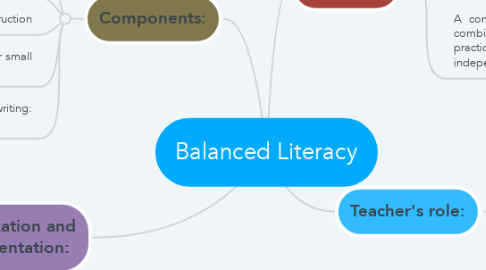Balanced Literacy
by Meg Volz

1. Components:
1.1. Interactive read aloud: whole and small group instruction
1.2. Shared reading: whole and small group instruction
1.3. Guided reading: small group instruction
1.4. Literacy centers: independent or small group work
1.5. Independent reading and writing: independent work
2. Organization and implementation:
2.1. Classroom instruction typically includes a daily literacy routine of interactive read-alouds/shared reading, guided reading, language and literacy centers, and independent reading and writing
2.2. Teachers need books and resources
3. What it is:
3.1. An approach to teaching literacy that uses authentic texts and tasks with a heavy emphasis on writing, comprehension, reader response, and literature while also including phonics, word identification, spelling, and writing.
3.2. A comprehensive view of literacy that combines explicit instruction, guided practice, collaborative learning, and independent reading and writing
4. Teacher's role:
4.1. Making decisions moment by moment on the best way to proceed with instruction
4.2. Reading a text to whole or small groups
4.3. Working with small guided reading groups
4.4. Differentiating instruction
4.5. Monitoring students working independently at centers and reading and writing independently


